El anatsui old man’s cloth – El Anatsui’s “Old Man’s Cloth” is a captivating fusion of art and culture, where recycled materials tell tales of history, identity, and the human experience. From the streets of Ghana to global art stages, Anatsui’s tapestries weave together vibrant colors, intricate textures, and profound meanings.
His innovative use of bottle caps as a medium challenges traditional notions of art, while his exploration of cultural symbolism connects viewers to the rich heritage of Africa and beyond.
El Anatsui
El Anatsui is a renowned Ghanaian sculptor and installation artist known for his captivating artworks created from recycled materials, primarily metal bottle caps. Born in 1944 in Anyako, Ghana, Anatsui’s artistic journey began at the College of Art, University of Science and Technology in Kumasi, Ghana, where he studied sculpture.
His artistic style was significantly influenced by traditional African art, particularly the woven textiles and metalworking techniques of his native Ghana.
Major Influences and Inspirations
Anatsui’s artistic style is a unique blend of traditional African craftsmanship and contemporary art. His use of recycled materials, particularly bottle caps, reflects his commitment to sustainability and environmental consciousness. The vibrant colors and intricate patterns of his artworks draw inspiration from traditional African textiles, while the use of metal evokes the rich history of metalworking in Ghana.
Anatsui’s artworks often explore themes of identity, history, and the interconnectedness of human experiences.
Old Man’s Cloth: Concept and Symbolism
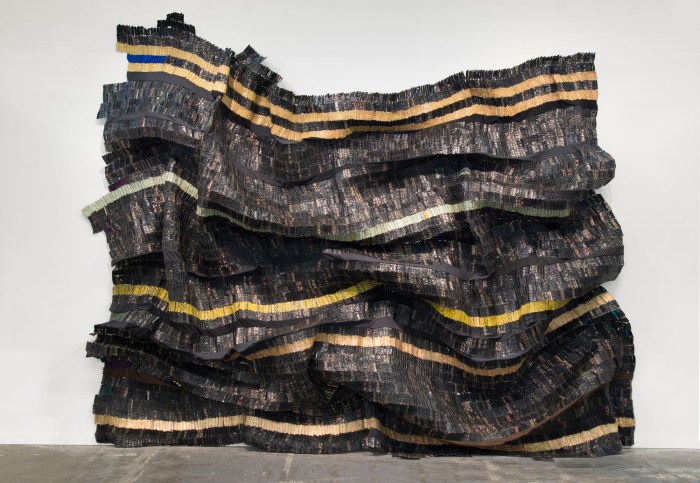
Significance of “Old Man’s Cloth” Motif
El Anatsui’s “old man’s cloth” is a central motif that embodies his exploration of cultural identity, history, and materiality. It draws inspiration from the traditional Ghanaian garment, a symbol of respect and wisdom worn by elderly men. Anatsui’s use of this motif reflects his deep connection to his African heritage and the value he places on tradition.
Recycled Materials and Cultural Context
Anatsui’s use of recycled materials, primarily discarded liquor bottle caps, adds a layer of symbolism to his work. These materials represent the remnants of consumption and globalization, highlighting the environmental and cultural consequences of modern society. By transforming these discarded objects into works of art, Anatsui gives them a new life and meaning, challenging conventional notions of value and beauty.
Techniques and Materials: El Anatsui Old Man’s Cloth
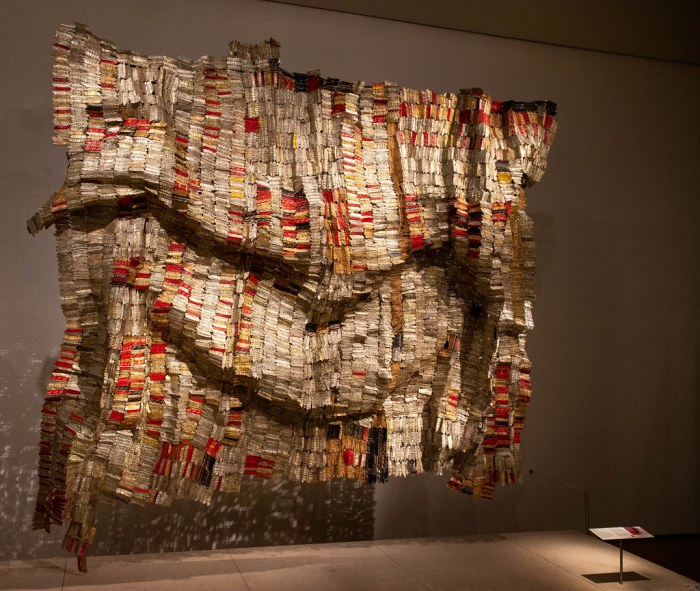
El Anatsui’s artistic prowess lies in his innovative use of materials and unique techniques. One of his most distinctive features is his incorporation of recycled metal bottle caps into his large-scale tapestries.
Anatsui meticulously collects and flattens discarded bottle caps, transforming them into vibrant and textured elements. He carefully arranges and sews these caps together, creating intricate patterns and forms that shimmer and cascade like metallic fabric.
Sewing Technique
Anatsui’s signature sewing technique is crucial to the structural integrity and aesthetic appeal of his tapestries. He uses a combination of hand-sewing and machine-stitching to join the bottle caps, creating a dense and durable fabric-like material.
- Hand-sewing:Anatsui meticulously hand-sews the bottle caps together using a needle and thread, ensuring precision and control over the placement and tension of each cap.
- Machine-stitching:To reinforce the hand-sewn joints and achieve a more uniform appearance, Anatsui employs machine-stitching along the edges of the caps. This combination of techniques enhances the durability and longevity of his tapestries.
Visual Impact and Interpretation
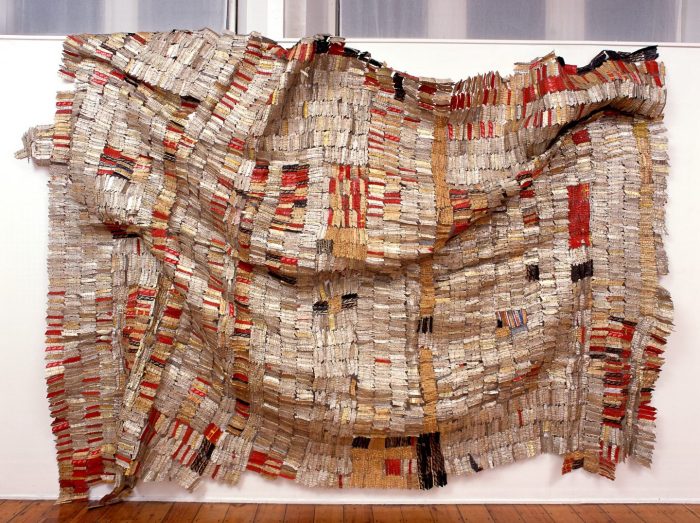
El Anatsui’s “old man’s cloth” tapestries create a profound visual impact through their intricate textures, vibrant colors, and dynamic compositions. These elements combine to evoke a sense of movement, energy, and cultural richness.
El Anatsui’s “Old Man’s Cloth” is an iconic artwork made from recycled bottle caps. It explores themes of identity, tradition, and globalization. Interestingly, another material that has found artistic expression is brass, as seen in the link bd . This durable metal is used in various sculptures and ornaments, showcasing the versatility of materials in contemporary art.
Returning to El Anatsui’s masterpiece, the bottle caps not only symbolize discarded consumer culture but also create a captivating tapestry of colors and textures, reflecting the richness and diversity of African history and culture.
Light and Texture
The use of light and texture in Anatsui’s tapestries is central to their expressive qualities. The metallic bottle caps reflect and refract light, creating a shimmering and iridescent surface that captivates the viewer’s attention. The caps’ irregular shapes and textures create a tactile and dynamic quality, inviting viewers to explore the work with their eyes and hands.
Color and Symbolism
Anatsui’s use of color is equally striking. The vibrant hues of the bottle caps, ranging from golds and silvers to blues and greens, create a sense of energy and movement. These colors also carry cultural significance, with gold symbolizing wealth and power, and blue representing spirituality and tranquility.
Diverse Interpretations
Anatsui’s tapestries have elicited a wide range of interpretations from viewers. Some see them as representations of African history and culture, while others interpret them as commentaries on globalization and consumerism. The tapestries’ abstract and evocative nature allows for multiple interpretations, inviting viewers to engage with the work on their own terms.
Cultural Significance and Legacy
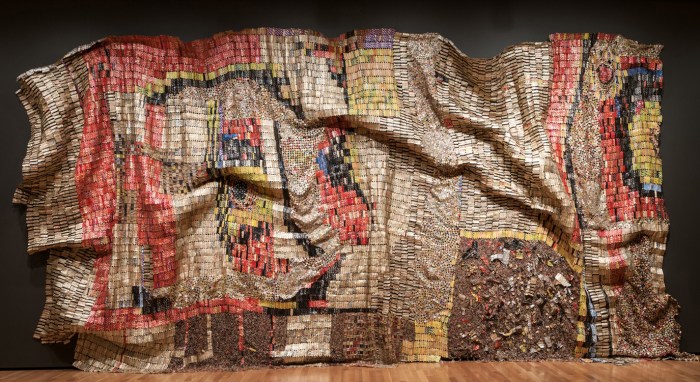
El Anatsui’s art holds immense cultural significance both within Africa and globally. His innovative use of recycled materials and vibrant colors has challenged traditional notions of art and representation.
Influence on Contemporary Artists
Anatsui’s work has had a profound impact on contemporary artists, inspiring them to explore unconventional materials and techniques. His use of everyday objects and discarded materials has encouraged artists to question the boundaries of art and to consider the potential of repurposing discarded items.
Global Recognition
Anatsui’s art has gained international recognition and has been exhibited in prestigious museums and galleries worldwide. His work has helped to reshape the global art landscape and has brought African art to the forefront of contemporary discourse.
Challenging Traditional Notions
Anatsui’s art challenges traditional notions of beauty and value. By using discarded materials, he subverts the idea that art must be created from precious or expensive materials. His work also critiques consumerism and waste, highlighting the environmental and social issues associated with the overconsumption of resources.
Comparative Analysis
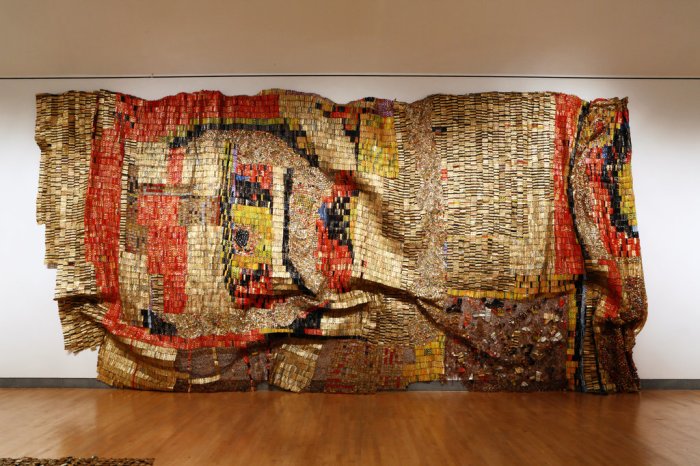
El Anatsui’s “old man’s cloth” tapestries are unique in their use of recycled materials, but they share similarities with other works of art that explore similar themes.
One notable comparison is with the work of American artist Alison Saar. Saar’s sculptures often incorporate found objects, including discarded clothing and other materials. Like Anatsui, Saar’s work addresses issues of identity, history, and the African diaspora.
Materials
Both Anatsui and Saar use recycled materials in their work, but they approach the use of these materials differently. Anatsui uses metal bottle caps and other discarded aluminum objects, while Saar incorporates a wider range of materials, including wood, fabric, and found objects.
Techniques
Anatsui’s tapestries are created by sewing together thousands of bottle caps. This labor-intensive process results in intricate and textured works that shimmer and move in the light. Saar’s sculptures, on the other hand, are often assembled from a variety of materials, and her techniques vary depending on the specific piece.
Artistic Intent
Anatsui’s work is often seen as a celebration of African culture and history. His use of recycled materials reflects the importance of reuse and recycling in many African cultures. Saar’s work, on the other hand, explores a wider range of themes, including identity, history, and the African diaspora.
Exhibition and Display
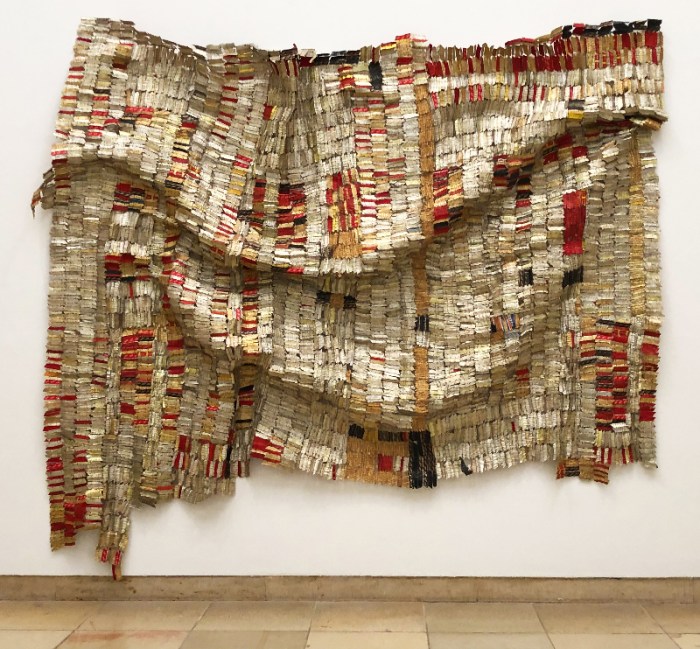
El Anatsui’s large-scale tapestries present unique challenges and considerations for exhibition. Their monumental size, delicate materials, and complex installation requirements demand careful planning and specialized techniques.
Lighting
Lighting plays a crucial role in showcasing the intricate details and reflective surfaces of Anatsui’s tapestries. Natural light can create dramatic effects, but it can also cause fading and damage over time. Artificial lighting, such as halogen or LED fixtures, provides more control and allows for precise illumination of specific areas.
Installation
Installing Anatsui’s tapestries requires specialized knowledge and equipment. The weight and size of the tapestries necessitate secure mounting systems and careful handling. The tapestries are often suspended from the ceiling or hung on walls, with additional supports to prevent sagging or damage.
Conservation
The preservation of Anatsui’s tapestries is paramount, given their delicate materials and large size. Regular cleaning and maintenance are essential to prevent dust accumulation and damage. The use of archival materials and proper storage conditions help ensure the longevity of these artworks.
Notable Exhibitions, El anatsui old man’s cloth
Anatsui’s tapestries have been showcased in prestigious exhibitions worldwide, including:
“El Anatsui
Triumphant Scale” at the Brooklyn Museum (2010)
“El Anatsui
When I Last Wrote to You About Africa” at the Haus der Kunst, Munich (2012)
“El Anatsui
Five Decades” at the Royal Academy of Arts, London (2019)
FAQ Section
What is the significance of “Old Man’s Cloth” in El Anatsui’s work?
It represents the cultural significance of clothing and textiles in African societies, particularly the role of elders and the passing down of traditions.
How does El Anatsui’s use of recycled materials contribute to his art?
It highlights the environmental and social issues surrounding waste and consumption, while also adding a unique aesthetic dimension to his tapestries.